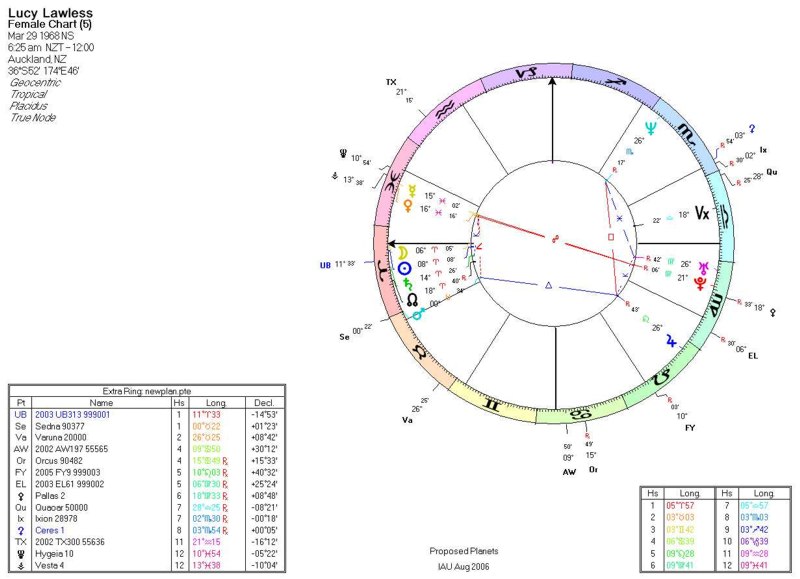Planets or Pla-nots: Solar Fire Has You Covered!
It’s been an exciting week for the International Astronomical Union meeting in Prague!
First, on August 16, 2006, some astronomers proposed a new definition for "planet" that would result in the addition of several cosmic entities as new planets and others to be under consideration. Besides reaffirming the solar system status of Pluto, the International Astronomical Union draft resolution had recognized 2003 UB313, the farthest-known object in the solar system; Pluto's largest moon, Charon; and the asteroid Ceres, which was a planet in the 1800s before it got demoted. 2003 UB313 has been nicknamed Xena, but has no official name. If the resolution had been approved, the 12 planets in our solar system listed in order of their proximity to the sun would have been Mercury, Venus, Earth, Mars, Ceres, Jupiter, Saturn, Uranus, Neptune, Pluto, Charon, and the temporarily named 2003 UB313 (aka Xena).
However, there was such controversy over this new system that an alternate resolution was adopted on August 24, 2006 (the session began at 2 pm and ended at 3:38 pm) in Prague, Czeck Republic. It sets up a three-tiered classification scheme with eight “planets”; a group of “dwarf planets” that would include Pluto, Ceres, Xena and many other icy balls in the outer solar system; and thousands of “smaller solar system bodies,” like comets and asteroids.
The resolution describes a dwarf planet as:
an object that: is in orbit around a star but is itself not a star;
has sufficient mass for its self-gravity to overcome rigid body forces so that it assumes a hydrostatic equilibrium (nearly round) shape;
has not cleared the neighborhood around its orbit;
is not a satellite.
This definition reclassifies Pluto from a planet to a dwarf planet because it has not cleared the neighborhood of its orbit (the Kuiper Belt). (This definition was taken from Wikipedia on August 24, 2006). At this stage Pluto, Ceres and UB 313 (nicnamed Xena) have been officially cited as dwarf planets. However, others still under consideration include Sedna, Orcus, Quaoar, Varuna, Ixion, Chaos and other numbered celestial bodies.
Following the announcement of the reclassifcation of Pluto by the IAU, the phone didn't stop ringing with reporters wanting to know what this change would mean to astrologers. Despite the fact that those of us with planets in the last 6 degrees of the mutables would love to eliminate Pluto from the solar system altogether, we assured those inquiring reporters that astrologers would still be using Pluto in charts.
(For a PDF of Wall St. Journal article Pluto's "demotion" and astrology, click here.)While we can all agree that Pluto will remain an important part of astrological work, we can also see that the official designation of "icy dwarfs" or "dwarf planets" offers exciting prospects for greater understanding for astrologers. We want you to know that you can rely on Solar Fire to do your calculations.
The latest update for Solar Fire (version 6.0.29) now has an Extra Ring Points file that includes Ceres and Xena as well as other "dwarf" planets. Once you have downloaded this dynamic up-to-date version of Solar Fire, you can view the New and Possible Planets page by clicking on View/Page Topic Index/General/New and Possible Planets. Alternatively you can create your own Extra Ring Points chart to see where these planets fall in your chart. Please note that Charon is a twin of the planet Pluto.
You can now download the latest patch update at http://alabe.com/dlpage.htm.
We couldn't help but wonder where Xena fell in Lucy Lawless' chart (she is TV's Xena: TheWarrior Princess). Would it surprise you to know that Xena (2003 UB313 is part of a stellim in Aries that includes her Sun, Moon, Saturn and North Node? Below is her chart using the newplanets extra point file in the latest Solar Fire patch. And, if you have any suggestions or thoughts about what these new planets mean in astrological terms then please feel free to email me at madalyn@alabe.com
For more info or to order by phone call:
1-800-THE-NOVA
(1/800/843-6682)
Email: astrolabe@alabe.com
To subscribe to AUGuries, the Astrolabe User Group e-letter, visit the AUGuries archives page.
